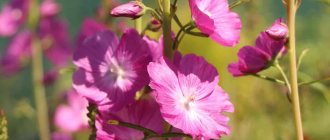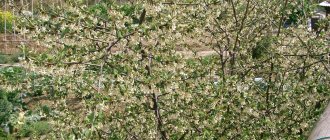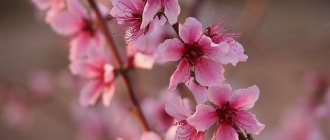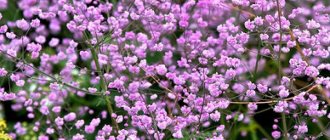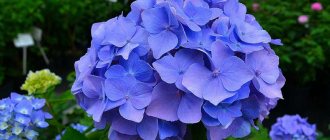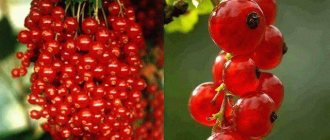Loading…
Loading…
Sunflower or helianthemum is a cute and unpretentious perennial plant that will be a wonderful decoration in the garden. The perennial sunflower is known for its variety of flower colors: from soft white to bright orange or mysterious purple. This persistent subshrub will take a liking to unsightly rocky areas and will decorate the garden with its cheerful appearance.
Description and characteristics of the perennial flower Sunflower
Sunflower, or helianthemum, is a large genus of the Cistus family, uniting about 80 species of plants. Its representatives can be found in the coastal and mountainous regions of both American continents, in the Mediterranean part of Europe, in the south and center of Asia, and in North Africa.
Sunflowers are annuals and perennials, subshrubs and herbaceous plants. What unites helianthemums is that they belong to the evergreen representatives of the flora, growing easily and quickly.
Important! Among other popular names for this flower, you can hear the following: “tender”, “stone flower”, “stone rose”, “sunny rose”, “frosty grass”.
Bright, beautifully blooming helianthemum grows quickly, is frost-resistant and unpretentious
The long stems of flowers can be either straight, spreading, or creeping along the ground. Their surface is slightly pubescent. The size of helianthemum shoots varies between 10-45 cm.
The leaves of the flowers are simple, oval or slightly elongated, their edges are usually slightly curved down. The plates are located opposite on the shoots. Depending on the type and variety of helianthemum, the leaves can be painted in all shades of green and look very decorative.
Sunflower inflorescences usually have a complex raceme shape, but simple single flowers are also found. Each of them consists of 5 separate petals. The color palette of helianthemum flowers is very rich. You can find all shades of yellow, white, pink, orange, blue, blue and lilac tones. In the middle of each flower there are many bright yellow stamens. Helianthemum does not have a pronounced aroma. However, the bright color of the corolla of the flower and the large amount of pollen attracts bumblebees, bees and other pollinating insects.
Helianthemum blooms profusely and lasts a total of 30-35 days. Its period depends on what weather prevails in the summer. In a hot, sunny season, helianthemum buds will begin to appear and open early - in the first half. If the summer is cool and rainy, then flowers should be expected no earlier than July-August.
The fruit of Helianthemum is an upper one- or three-locular capsule containing a large number of small seeds.
Sunflower coinifolia is one of the types of helianthemum that is commonly used in ornamental gardening.
Advantages and disadvantages of cultivation
The advantages and disadvantages of helianthemum are presented in table form:
| pros | Minuses |
|
|
Types and varieties of Sunflowers
Of the variety of sunflower species, only a few are used in ornamental gardening. However, based on them, many varieties of helianthemum have been bred, providing a wide choice of shoot lengths, shapes and colors of flowers and leaves.
Monetary sunflower
The coin-shaped, coin-leaved or common sunflower (lat. Helianthemum nummilarium, also known as vulgare) is characterized by the shape of a subshrub with densely pubescent, spreading, highly branched stems about 40-45 cm high. In the wild, this flower is found on the Mediterranean coast. The upper side of the oval leaf blades of this helianthemum is dark green, the lower side is grayish, covered with pile. Sunflower flowers are combined into one-sided brushes of up to 12 pieces each. This is a winter-hardy species that does not need shelter for the winter.
Henfield Brilliant
The sunflower variety Henfield Diamond is the winner of the prestigious Award of Garden Merit from the Royal Horticultural Society of Great Britain. Plant height is 15-20 cm. The wildly growing dense subshrub forms a picturesque flower carpet from late spring to mid-summer. The leaves of this sunflower are dark, silver-green in color. The flowers are about 3 cm in diameter. The petals are deep orange, with yellow stamens clearly visible against their background. Each bud of this helianthemum opens for only one day, but a very large number of them are formed, which allows flowering to last for a long time.
Henfield Diamond - winner of the AGM Award of the Royal Horticultural Society of Great Britain
Cerise Queen
The length of the shoots of the sunflower variety Cerise Queen (Cherry Queen) averages from 10 to 25 cm. The foliage is shiny, rich green in color. The flowers are double, bright red. Among the advantages of this sunflower is its ability to tolerate strong temperature fluctuations.
Cerise Queen is a double helianthemum that is not afraid of sudden temperature changes
Belgravia Rose
Sunflower Belgravia Rose has long (15-20 cm) dense shoots, gray-green leaves and bright cherry-pink flowers, shaped like poppy heads. The color of their petals is usually darker in the central part, but becomes lighter at the edges. This variety of sunflower tolerates drought well. However, the flower looks best if it is given occasional watering during the hottest periods of summer.
Tender Belgravia Rose is actually very hardy and tolerates drought well
Sunflower Apennine
The homeland of the Apennine sunflower (lat. Helianthemum apenninum) is Asia Minor and the southwest of the European continent. The bushes of this helianthemum are usually of medium size (20-25 cm). The leaves are small, up to 1 cm long, elongated, lanceolate, pubescent on the reverse side. Racemose inflorescences unite small buds about 1.5-2 cm in diameter. This helianthemum usually blooms in May-June.
Wisley Pink
The most popular variety of the pink variety of Apennine sunflower is Wisley Pink. It is distinguished by dense leaves of pale gray and green color. The flowers are soft pinkish and appear in late spring or early summer. This sunflower looks very beautiful growing among rocks or planted in containers.
The Apennine sunflower Wisley Pink looks very decorative against the background of stones
Alpine sunflower
In the wild, the alpine sunflower (lat. Helianthemum alpestre) can be found in the mountainous regions of the Pyrenees and the Balkans. Its shoots do not grow higher than 10 cm. The leaves of this helianthemum are tiny, only about 0.7 cm long. The plant produces low, lush mats covered with pale yellow flowers. The period of their appearance is from early to mid-summer.
Warning! Alpine sunflower, grown in garden conditions, requires mandatory shelter in winter.
Alpine sunflower bushes must be covered for the winter
Moon-shaped sunflower
Under natural conditions, the moon-shaped sunflower (lat. Helianthemum lunulatum) grows in the dry, rocky landscapes of the Maritime Alps. This subshrub is considered partially deciduous. Its straight branches eventually grow up to 25 cm and become spreading. The leaves are small, elongated, gray-green. Helianthemum flowers are bright yellow with an orange crescent-shaped spot at the base. Their diameter is 1.5 cm. Flowers are formed in the first half of summer.
Moonflower sunflower is a partially deciduous plant.
Arctic sunflower
Arctic sunflower (lat. Helianthemum arcticum) is a species currently recognized as endangered. Listed in the Red Book. In nature, it grows exclusively in Russia, in the Murmansk region, along the sea coast. This sunflower is a densely branching subshrub, the length of its shoots is from 10 to 40 cm. The color of the stems varies from green to purple, in the lower part they become woody. The complex inflorescences of Arctic Helianthemum usually contain from 3 to 6 golden-yellow flowers, each of which reaches about 2.5 cm in diameter. The period of their appearance is July.
Comment! Attempts to cultivate this flower have been made several times, but have not been particularly successful.
The rare Arctic sunflower grows only in Russia and is listed in the Red Book
Sunflower hybrid
The hybrid sunflower species (Helianthemum x hybridum) combines a large number of varieties obtained by crossing the Apennine and coinifolia helianthemums. Usually these are subshrubs 20-40 cm tall, forming thick mats or low pillows on the soil with numerous single flowers and green foliage. Most often, it is the hybrid sunflower that can be seen in flower beds in garden plots. It should be remembered that many varieties of this helianthemum need dry shelter for the winter.
Amy Baring
The Amy Baring hybrid sunflower variety originated in Scotland in the 1920s. The shoots of this plant form wide mats up to 12 cm in height. The leaves of this sunflower are narrow, elliptical in shape. The flowers are painted in a rich yellow tone with an orange central part. They appear in late spring.
Homeland of Amy Baring's hybrid sunflower - Scotland
Ben Affleck
Ben Affleck's sunflower looks very elegant: its silver-gray leaves serve as a picturesque backdrop for bright rich yellow or dark orange flowers with an orange center. The flowering period of this helianthemum occurs twice: in May-June and in September.
The Ben Affleck variety can bloom twice during the season.
Wisley White
The tremulous white flowers of the helianthemum variety Wisley White with pale yellow centers justify another popular name for this plant - “tender”. Its shoots usually reach 25 cm in length. The foliage of this helianthemum is silvery green. The budding period lasts from May to July. After its completion, the helianthemum needs careful pruning.
Tender Wisley White requires pruning at the end of the flowering period
Raspberry Ripple
The original coloring of the hybrid sunflower Raspberry Ripple really resembles crimson stains applied with watercolor paint. The delicate pink hue of the petals of its flowers darkens, filling with a bright blush, and in places, closer to the edges, pales almost to milky white. Shoots covered with grey-green elongated foliage usually grow up to 15-30 cm. This helianthemum blooms in late spring and lasts until mid-summer.
The coloring of Raspberry Ripple resembles stains made with crimson watercolor paint
Jubilee
The double lemon-yellow flowers of the beautiful Jubilee look extremely decorative against the background of light green foliage. The height of the stems is 20-25 cm. Helianthemum Jubilee blooms in late spring and early summer.
Jubilee's lemon-yellow flowers have a double structure
The Bride
The charming Ze Bride (Bride) attracts the eye with cream flowers with a golden “eye” in the center, forming a superb ensemble with silver-gray leaves. The height of its stems is about 20 cm. It blooms throughout the summer. This helianthemum looks great in rock gardens against the background of decorative stones.
The Bride's creamy inflorescences sparkle with a golden speck in the middle
Characteristics of the coin-leaved or coin-leaved sunflower (with photo)
Coin-shaped, coin-leaved, or common sunflower (Helianthemum nummularium).
According to the biological characteristics, the coin-leaved or common sunflower is a ground cover subshrub up to 50 cm high and up to 60 cm wide. The stems are pubescent, recumbent or erect. Leaves are lanceolate or oblong-oval. The leaf blades are smooth, dark green above, grayish-green below, fleecy, up to 5 cm long. The flowers are collected in one-sided inflorescences of yellow, white, pink or red. Up to 12 flowers can form in one inflorescence.
Varieties of common sunflower:
The most popular variety of coinifolia sunflower is “Gold Coin,” which is a perennial bush up to 30 cm high. It forms thick, dense turf. The flowers are white, pink, red, yellow, up to 2.5 cm in diameter. The leaves are silver-green. Flowering begins in May and ends in July. The variety has high frost resistance, so it winters successfully without shelter;
“Cerise queen” is a sunflower variety that is a spreading perennial subshrub that creates a lush, dense carpet. The height of the stems varies from 10 to 40 cm. The flowers are double, red, densely cover the bush and give the bush a spectacular appearance. Flowering lasts from July to August. The variety has many advantages, including ease of care, high frost resistance, and the ability to withstand severe temperature changes. Suitable for growing in central Russia.
Look at the photo to see what varieties of sunflower coinifolia look like in a garden plot, how effectively they create lush flowering carpets:
Reproduction methods
The most popular method of propagating the species sunflower is sowing seeds. Hybrid forms of helianthemum of the first series are often taken from cuttings, since it is this method that allows you to fully preserve all the characteristics that the mother plant has. It is also not difficult to propagate adult sunflowers by rooting cuttings.
Warning! Dividing or picking helianthemum bushes is strictly not recommended! This disrupts the functioning of the root system of the flower, which coexists in close symbiosis with lower fungi. Any damage to the roots disrupts mycorrhiza and contributes to the rapid death of the aboveground part of the helianthemum.
Growing Sunflower from Seeds
Most often, sunflower is grown from seeds by seedlings, but in milder, warmer climates, seedlings are also used. In the first case, strong grown seedlings have the opportunity to take root better in the ground. The advantage of the second is that there is no need to transplant the flower: the helianthemum is difficult to tolerate this procedure.
Layerings
Sunflower propagation by layering is carried out in the spring. The developed shoot is carefully tilted, pressed to the surface of the earth and sprinkled with soil, leaving the upper part free. Helianthemum cuttings are regularly watered and monitored. By autumn, the nodes of the sunflower shoot should take root. After this, the cuttings can be separated and transplanted to a new location. It is imperative to keep a lump of earth on the roots of the flower.
Cuttings
To propagate sunflowers by cuttings, the apical shoots without flowers are cut off by about 10 cm from the plant. They are placed in a container filled with peat or sand, under a transparent cover made of plastic or film. The soil under the improvised “greenhouse” is kept moist and condensed moisture is removed from time to time. After new leaves appear on the helianthemum cuttings, they can be considered established and planted in open ground.
Landing rules
Growing sunflowers in your own garden is quite simple. To plant it, you should choose a well-lit open area, and the suitable soil should be alkaline or neutral, and it must contain fine crushed stone and sand. Such flowers can also be grown on loamy soil, but before planting it is dug up and dolomite flour is added.
Since the bushes of this plant can grow very strongly in a short period of time, the distance between the planting holes should be at least 0.3 meters. At the same time, their depth should be such that a peat pot with a plant can be placed in them. Before planting, the seedlings are well watered, and then they are placed in pre-prepared planting holes; all existing voids should be filled with soil, the surface of which is then compacted around the flower. Planted bushes need abundant watering.
Planting and caring for the Sunflower flower
The sunflower is unpretentious - usually this flower grows quickly and easily. Following simple rules for planting and caring for helianthemum seedlings will help create optimal conditions for them, thereby keeping the plants in excellent shape and allowing them to remain decorative for a long time.
When growing sunflower from seeds, you should remember that it does not tolerate transplantation very well.
Timing of sowing and planting in open ground
Sowing sunflower seeds for seedlings is usually done in early March. It is taken into account that the germination period of this flower is quite long and takes about 4 weeks in total. In this case, the transfer of grown and strengthened plants to a permanent place in the garden can be done in late spring or early summer.
Helianthemum seeds should be sown directly in open ground no earlier than the first ten days of May. You definitely need to wait until the weather is finally warm outside (at night the air temperature should not drop below + 14 °C).
Sowing seeds for seedlings
Since any replanting invariably weakens the root system of the sunflower, the best option for containers for germinating seedlings of this flower are peat pots or tablets, or individual cups. 2-3 helianthemum seeds are sown in one container.
They do it like this:
- moisturize well and slightly loosen the substrate;
- spread sunflower seeds on the surface;
- lightly cover them with a thin layer of sand on top;
- moisten the planting again with a spray bottle;
- cover the containers with transparent film or glass;
- transfer to a warm (+ 18-24 ° C), well-lit with diffused light place;
- provide the helianthemum with daily ventilation and regular, gentle watering.
After the flower sprouts, the “greenhouse” is removed and the temperature is slightly lowered (+ 15-16 °C will be enough).
Caring for helianthemum sprouts at this stage comes down to moderate watering as the soil dries and systematically carefully loosening the soil surface around the seedlings.
When the seedlings grow, they will need to be thinned out by cutting off the weakest shoots in each pot at the base and leaving one of the strongest and most durable flowers.
1.5-2 weeks before transferring to open ground, helianthemum seedlings will need to be hardened. To do this, sunflower seedlings begin to be taken out into the open air in calm, windless weather. Initially, they are left in such conditions for a couple of hours, but every day they increase the time the flower seedlings stay on the loggia or in the yard, gradually bringing it up to a whole day.
Sunflower fruit - a capsule with small seeds
Preparing the site and soil
The area in the garden where it is planned to place a flower bed with sunflowers must meet the following requirements:
- well lit by the sun;
- be protected from strong winds, drafts and rain;
- have loose, well-drained soil with a neutral or alkaline reaction.
Advice! If the soil composition is too dense, it is recommended to add some sand or small crushed stone to it. Dolomite flour is added to loamy soil.
Transplanting
Planting sunflower seedlings in the ground follows these rules:
- In the prepared area, dig holes at a distance of at least 30 cm from each other. Their depth should be such that it is easy to place a peat pot with helianthemum roots.
- Immediately before planting, the sunflower seedling bushes are well watered.
- Place peat pots with flowers in the holes and carefully fill the empty spaces with soil.
- Lightly compact the surface of the earth around the sunflower stems.
- Water the helianthemum abundantly.
Aftercare and preparation for winter
Caring for sunflowers growing on the site is extremely simple. Basic Rules:
- Watering helianthemum is carried out only in the summer, during long dry periods. To do this, it is advisable to use settled, slightly warmed water in the sun. In spring and autumn, the helianthemum, as a rule, has enough moisture, which is provided by natural precipitation.
- A sunflower growing in nutritious soil does not require additional feeding. If necessary, before the beginning of the flowering period, you can add a little organic matter in liquid form to the soil. However, you need to remember that if there is an excess of nutrients, the sunflower will begin to grow shoots and foliage to the detriment of the flowers.
- To maintain a decorative appearance, helianthemums must be pruned regularly. About a month after the first buds appear, shoots with wilted inflorescences should be shortened by about 1/3. This procedure will also promote the formation of new helianthemum flowers.
The area in the garden where the sunflower grows must be well lit
Most types of sunflowers have good winter hardiness and in temperate latitudes do not need shelter for the winter. However, in some cases it is necessary to provide the flower with additional protection. It is required:
- helianthemum alpine;
- some varieties of hybrid sunflower, especially those with red flowers and silver leaves.
Advice! You can use hay, coniferous spruce branches, dry leaves or agrofibre as winter shelter for helianthemum.
Growing sunflower from seeds
Sowing seedlings
Usually helianthemums are sown directly into the ground, but in some circumstances it is advisable to grow sunflower seedlings at home and then plant the seedlings in the garden.
Helianthemum seeds are sown for seedlings in early March, and peat tablets or cups should be used as a container: the roots of the sunflower interact with certain beneficial fungi, and when transplanting or picking, the fungal layer is disturbed, and this can lead to disease and death of the plant. Therefore, helianthemum is not propagated by dividing the bush, it is not picked or replanted.
- Gladiolus is a symbol of courage and nobility
In the photo: How the sunflower blooms
The seeds are laid out in 2-3 pieces on the surface of a moist, loose substrate and only lightly sprinkled with vermiculite or sand, after which they are covered with film and kept under bright diffused light at a temperature of 18-24 ˚C.
The peculiarity of this crop is that seedlings can appear either in a week or in a month, but as soon as this happens, the film is removed from the crops, and the temperature is lowered to 15-16 ˚C. It has been noticed that sunflower seedlings develop better when there is a significant difference between day and night temperatures, which should be 4-5 degrees.
As soon as the seedlings grow and become stronger, cut off weak specimens in each cup at surface level so that they do not interfere with the development of strong ones. Caring for sunflower seedlings consists of watering and carefully loosening the soil around the seedlings.
Stone flower in landscape design
An unpretentious, fast-growing and exclusively decorative ground cover, helianthemum is widely used in landscape design. Examples of using sunflowers to decorate a garden are shown in the photo:
Helianthemum is an excellent element for creating beautiful cover on rocky or bare areas
A bright sunflower looks great in the foreground of almost any flower garden.
This flower is a real find for decorating picturesque borders along garden paths.
The sunflower goes well with stones in rock gardens, on alpine hills, and feels great on various screes and slopes
Helianthemum easily gets along with many drought-resistant perennials - sedum, ornamental grasses, allium, sage, lavender, speedwell, bluebells, flax
Sunflower also does well as a container plant
Site selection and soil preparation
Helianthemum prefers well-open and lit places; in dark conditions, the color saturation and decorativeness of the bud decreases, and growth slows down. You should not plant a flower in the shade of large trees. The optimal solution is an alpine slide or rockarium located on a small hill.
Any type of soil is suitable as a soil; sunflower feels best on sandy or stone substrates; calcareous areas are also suitable.
The plant does not tolerate waterlogging, so drainage is required. It is not recommended to plant the flower near high-lying groundwater or ponds.
There is no need for complex site preparation before planting. It is enough to increase the looseness and aeration of the soil with sand or peat, add a little organic matter, for example 2-3 kg of mullein per meter of flowerbed.
Sunflower Monetolifolia - what is it used to treat?
Sunflower is considered a medicinal plant and is actively used in folk medicine. Its stems, flowers and leaves are believed to have healing properties.
An infusion of sunflower herb is used:
- in the form of lotions as a wound healing agent;
- for dysentery;
- for colitis as an astringent;
- to get rid of the effects of stress, panic, and solve sleep problems;
- as an antiepileptic drug.
Pests and diseases
The main danger for the gentleman is the following problems:
- Rot due to excess moisture during heavy rains and melting snow. Affected plants are removed from the area, which is then watered with a solution of a fungicide such as Fundazol.
- Powdery mildew appears as a white coating on the leaves, which fades over time. This usually occurs due to excessive humidity, improper pruning, dense plantings or sudden changes in temperature. Eliminated with fungicidal drugs.
- Aphids and thrips suck cell sap from leaves, weakening them and leading to death. Biological insecticides such as Fitoverm, Trichopolum, Actofit will provide a therapeutic effect.
Description
Helianthemums are diverse. Among them there are perennial and annual, herbaceous rhizomatous varieties and semi-shrubs, creeping and erect. The height of plants rarely exceeds 30 cm. The leaves are narrow-lanceolate or oval, with or without pubescence, opposite in the middle part of the stems and alternate at the tops of the shoots.
The flowers are small (about 2 cm in diameter), without fragrance, five-petaled, with numerous stamens. The color depends on the species and can be yellow, pink, white, orange.
Flowering of all species occurs at approximately the same time. In hot summers it occurs in June, in cool summers – in July. Numerous seeds are formed in three-locular or single-locular boxes.
Description
A type of evergreen creeping plant. Stems are branched. The shrub is covered with bright yellow flowers, shaped like a saucer. The center of the flower is a tall stigma surrounded by several orange stamens. Sunflower coinifolia grows on flat rocky soils. Less common in the field. The plant is not afraid of dry areas.
In nature, there are shrubs with yellow flowers, while garden plants have shades from white to dark red.
The coinifolia sunflower blooms throughout the summer. The main flowering period is from May to July. The flowers of the plant are an excellent honey plant for bees, and the leaves are food for the larvae of butterflies and moths.
general characteristics
Perennial or annual plants; usually subshrubs, less often herbs.
The stem is erect or creeping, 10-30 cm tall.
The leaves are oval to linear-lanceolate in shape, simple, placed oppositely along the length of the stem.
The flowers are mostly yellow, but can also be orange, pink or white, and are collected in a racemose inflorescence.
The fruit is a capsule.
Representatives of the genus bloom and bear fruit in approximately the same period: in years with hot summers - in May and June, or in July and August if the summer is rainy and cold.
A significant portion of sunflower species form ectotrophic contacts with fungi from the family ( Tuberaceae
).



